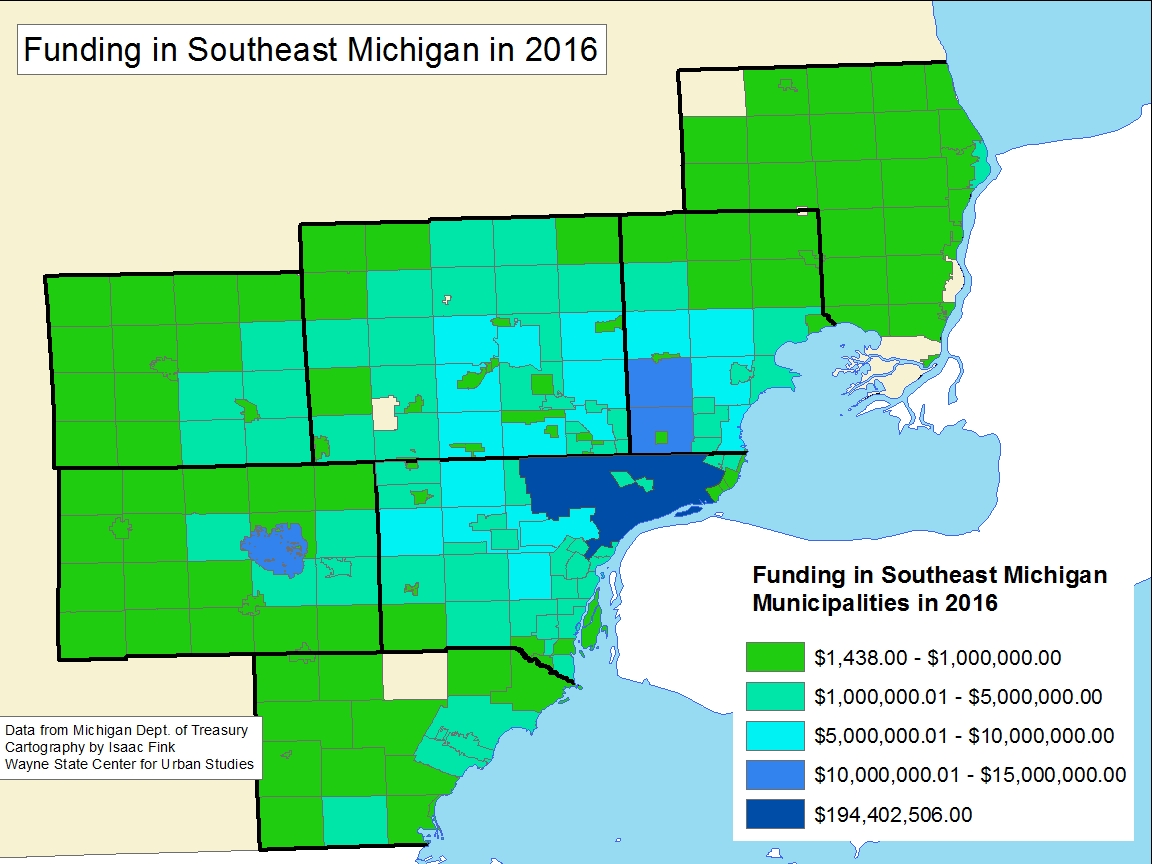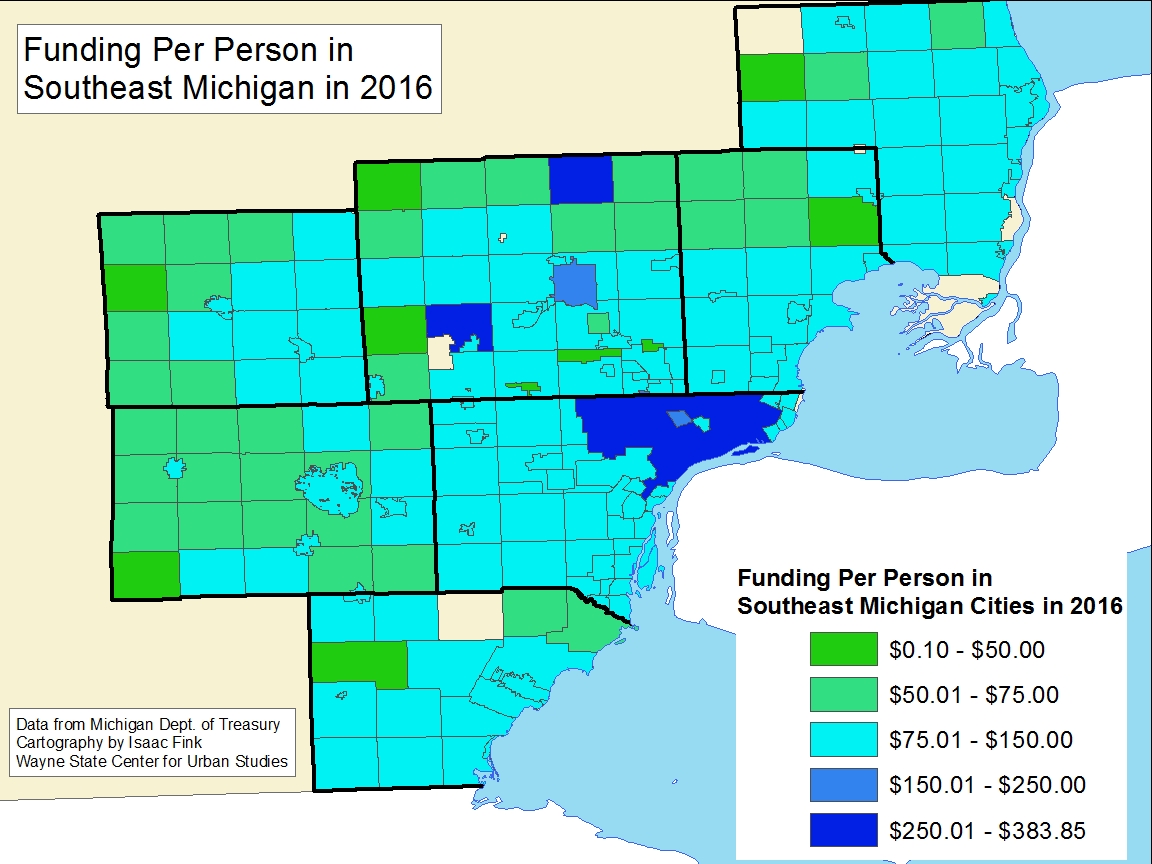Municipalities across Michigan have experienced a decline in Revenue Sharing funds in recent years as monies have been diverted toward the State’s General Fund. Between Fiscal Year 2015 and 2016 the municipalities in Southeastern Michigan experienced an average decline in revenue sharing of 0.59 percent. For Fiscal Year 2017 though, the state is expecting to increase revenue sharing monies by 1.2 percent in Southeastern Michigan, on average. The purpose of this post is to show how Revenue Sharing payments declined between 2015 and 2016 and how the capita disbursement varies between communities.
The funding map below refers to the total amount of Revenue Sharing each municipality received in 2016-this total combines both the Constitutional and Revenue Sharing Funds. For the Constitutional Revenue Sharing Payment there is a total distribution rate, which has declined over the last several years. For FY 2016 the rate was 75.694800 and in FY 2015 that rate was 76.1932l; in FY 2017 it is projected to be 76. 921299. For a municipalities’ total annual Constitutional Revenue Sharing payment to calculated, the total rate is multiplied by the 2010 population for each city, village and township, despite the fact some municipalities’ populations may have increased since then. The state determines the Constitutional Rate using 15 percent of the gross 4-percent sales-tax collections (the other 2 percent of Michigan’s gross sales-tax collections are designated for educational purposes). This means 15 percent of state sales tax revenue should be distributed to Michigan’s municipalities. Using Detroit as an example, the 2010 population was 712,552. This is multiplied by 75.698400, bringing the total Constitutional Revenue Sharing amount that Detroit was to be awarded in 2016 to $53,939,054. Detroit’s Constitutional Revenue Sharing payment for 2016 accounted for about 28 percent of the Revenue Sharing Funds it was awarded.
Example:
- 2016 Constitutional Revenue Sharing Payment= 2010 Population x 75.6984
- 2016 Detroit Constitutional Revenue Sharing Payment of $53,939,054= 712,552 x 75.698400
In addition to Constitutional Revenue Sharing, there is also Statutory Revenue Sharing, which for Fiscal Years 2015, 2016 and 2017 have been called CVT (City, Village and Township) Payments. For 2015 and 2016, according to the Michigan Department of Treasury, payments were based on whether or not a municipality met specific Accountability and Transparency requirements. If these requirements were, met a municipality was eligible to receive up to 78.51044 percent of their 2010 total statutory payment, or a payment equal to the population multiplied by $2.64659-whichever was greater. The formula for 2010 statutory payments was the total amount a municipality received in FY 2009 multiplied by 88.94 percent, less the FY 2010 Constitutional amount, multiplied by the FY 2010 statutory payment percentage, according to the Michigan Department of Treasury.
For the City of Detroit it was awarded $140,463,452 in Statutory Revenue Sharing in 2016. This number was calculated by multiplying its total 2010 Statutory Revenue Sharing payment of $178,910,540 by .7851044 (max eligible percentage of 2010 Statutory Payment). In total, Detroit’s Statutory Revenue Sharing Payment accounted for 72 percent of its total Revenue Sharing Payment.
Example:
- 2016 Statutory Revenue Sharing Payment=2010 Statutory Revenue Sharing payment x .7851044 (max eligible percentage of 2010 Statutory Payment)
- 2016 Detroit Statutory Payment= $178,910,540 x .7851044=$140,463,452
While Michigan’s Constitutional Revenue Sharing remains enshrined in the State’s Constitution, Statutory Revenue Sharing formulas are subject to regular legislative modification. Constitutional Revenue Sharing rates can decrease when overall revenue declines, as it tends to during recessions, or when the population of a municipality declines. However, Constitutional Revenue Sharing payments are not subject to the changes Statutory Revenue Sharing payments experience. For example, just between 2014 and 2015 Statutory Revenue Sharing payments went from being called Economic Vitality Incentive Program Payments, where a municipality could receive up to 76.18459 percent of its 2010 Statutory Payment if it met three conditions (Accountability and Transparency, Consolidation of Services, and Employee Compensation) to City, Village and Township Revenue Sharing Payments. As noted above, the current Statutory Payment formula is based on whether or not a municipality met only Accountability and Transparency requirements. Also the percentage rate is 78.51044 percent of a communities’ 2010 total statutory payment. As noted above, there were no changes between the 2015 and 2016 Statutory Revenue Sharing formula.
As shown below, Revenue Sharing payments vary between municipalities, at least in part, due to the fact the Constitutional Revenue Sharing rates are based off of population numbers. Revenue Sharing payments for FY 2016 ranged between about $20,000 (Emmett Village in St. Clair County with a population of 323) to above $194 million (Detroit with a population of about 700,000). As the map shows, Detroit had the largest Revenue Sharing payment in the region, with Ann Arbor, Warren and Sterling Heights coming in behind Detroit for payment amounts. The more rural communities, with the lesser populations, also received lesser total Revenue Sharing payments.
As noted, the average overall Revenue Sharing decline in Southeastern Michigan between 2015 and 2016 was .59 percent. While the map below shows the overall Revenue Sharing payment change between 2015 and 2016, the contributing factor was the decrease in the Constitutional Revenue Sharing rate between 2015 and 2016; the Statutory Revenue Sharing formula remained the same. Also, one of the more notable trends demonstrated in the second map, below, is that municipalities in the region currently, or previously, deemed financially unstable experienced less of a decline in Revenue Sharing than majority of the other municipalities in the region. This is due to FY 2016 $5 million Financially Distressed Cities, Villages and Townships Grant Program, which was created to help financially struggling municipalities move toward financial stability. As part of this program, the Michigan Legislature mandated that a single municipality should not receive more than $2 million. Cities such as Ecorse, Inkster and Highland Park were recipients of this grant, boosting the total amount of Revenue Sharing funds they were appropriated.
Inkster experienced a .38 percent decline, Ecorse experienced a .34 percent decline, and Highland Park experienced a .23 percent decline. Although Detroit was not a recipient of this grant, it experienced a .18 percent decline; the smallest in the region.
In 2016 the projected amount of Revenue Sharing Detroit was to receive was $194,402,506, as demonstrated in the first map above. This translates to $279.54 per person in the city, which is shown in the map below. That number was calculated by taking the projected 2016 Revenue Sharing dollars and dividing it by the most recent population numbers provided by the U.S. Census Bureau. The only other community in the region that received a higher per capita amount of Revenue Sharing dollars was Oxford Township in Oakland County ($383). In total, there were 27 municipalities throughout the region with a per capita Revenue Sharing amount above $100 per person.
In the our next post, we will take a deeper look as to how Revenue Sharing payments have declined over time in Southeastern Michigan. We know that payments have declined over the last several years and will be able to see some of the hardest hit communities in Southeastern Michigan.


